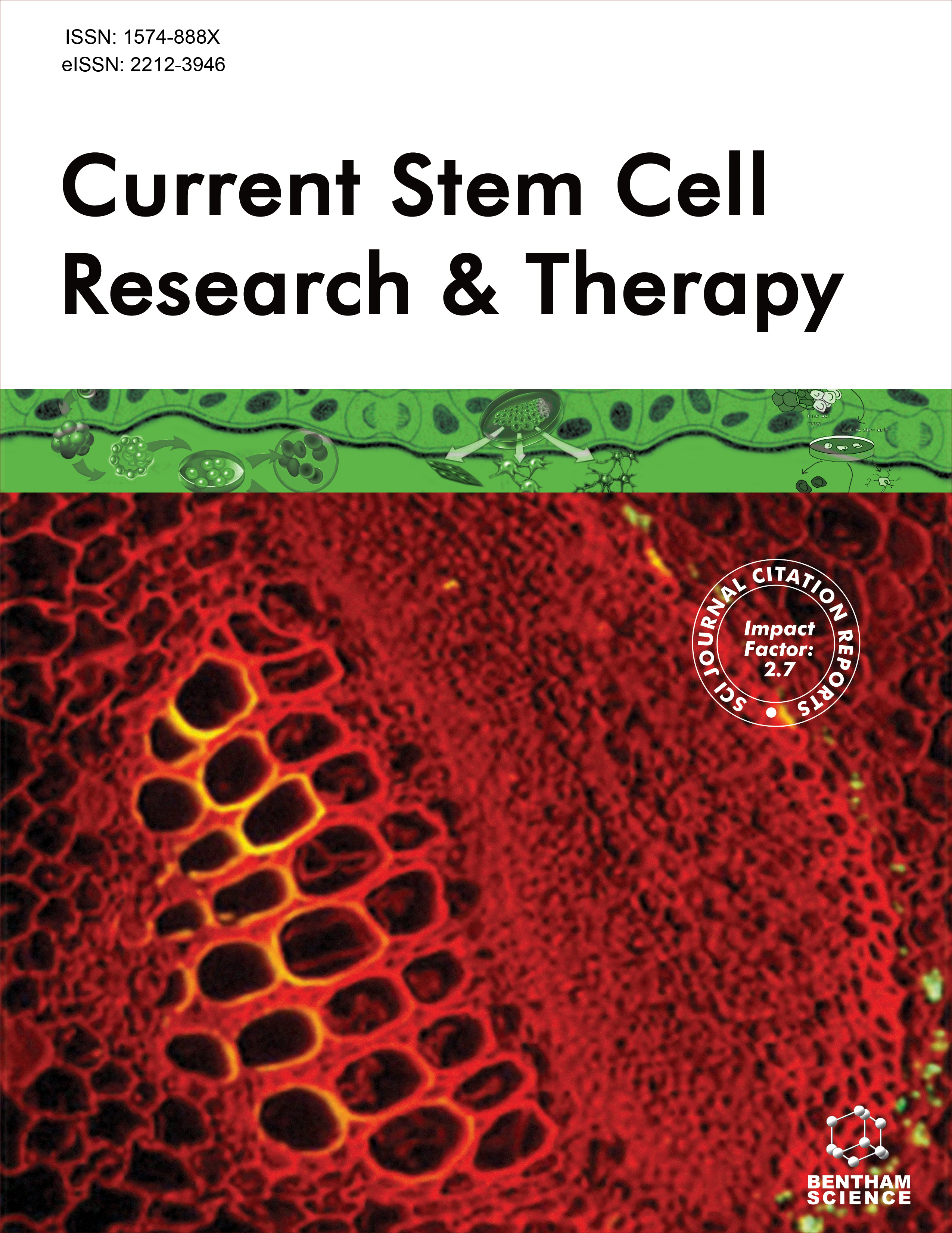- Home
- A-Z Publications
- Current Stem Cell Research & Therapy
- Previous Issues
- Volume 17, Issue 4, 2022
Current Stem Cell Research & Therapy - Volume 17, Issue 4, 2022
Volume 17, Issue 4, 2022
-
-
Efficacy of Mesenchymal Stem Cells from Human Exfoliated Deciduous Teeth and their Derivatives in Inflammatory Diseases Therapy
More LessAuthors: Junxiang Su, Xuejun Ge, Nan Jiang, Ziqian Zhang and Xiaowen WuMesenchymal stem cells derived from postnatal orofacial tissues can be readily isolated and possess diverse origins, for example, from surgically removed teeth or gingiva. These cells exhibit stem cell properties, strong potential for self-renewal, and show multi-lineage differentiation, and they have therefore been widely employed in stem cell therapy, tissue regeneration, and inflammatory diseases. Among them, stem cells fro Read More
-
-
-
Extracellular Vesicles in the Pathogenesis, Treatment, and Diagnosis of Spinal Cord Injury: A Mini-Review
More LessAuthors: Yang Wang, Hualiang Xu, Jian Wang, Hanxiao Yi and Yancheng SongBackground: Benefiting from in-depth research into stem cells, extracellular vesicles (EVs), which are byproducts of cells and membrane-wrapped microvesicles (30-120 nm) containing lipids, proteins, and nucleic acids, may cast light on the research and development of therapeutics capable of improving the neurological recovery of spinal cord injury (SCI) animals. However, the mechanistic modes of action for EVs in alleviating t Read More
-
-
-
Mesenchymal Stem Cells Derived from Umbilical Cord Blood Having Excellent Stemness Properties with Therapeutic Benefits - a New Era in Cancer Treatment
More LessAuthors: Suman K. Ray and Sukhes MukherjeeMesenchymal stem cells (MSCs) are the most promising candidates for cellular therapies, and most therapeutic applications have focused on MSCs produced from adult bone marrow, despite mounting evidence that MSCs are present in a wide range of conditions. Umbilical cord blood (UCB) is a valuable source of hematopoietic stem cells, but its therapeutic potential extends beyond the hematopoietic component, which also sug Read More
-
-
-
HSC and miRNA Regulation with Implication for Foetal Haemoglobin Induction in Beta Haemoglobinopathies
More LessAuthors: Chinwe Okeke, Ufele Silas, Obiageli Nnodu and Odoh ClementinaSickle cell disease (SCD) is one of the most common haemoglobinopathies worldwide, with up to 70 % of global SCD annual births occurring in sub-Saharan Africa. Reports have shown that 50 to 80 % of affected children in these countries die annually. Efforts geared towards understanding and controlling HbF production in SCD patients could lead to strategies for effective control of globin gene expression and therapeutic appro Read More
-
-
-
Intravenous Injection of SDF-1α-overexpressing Bone Marrow Mesenchymal Stem Cells has a Potential Protective Effect on Myocardial Ischemia in Mice
More LessAuthors: Ruihua Wang, Wen Wei, Shuling Rong, Ting Wang and Bao LiBackground: Neutrophils are involved in the injury of myocytes during myocardial ischemia (MI). Stem cells migrate to the site of myocardial injury under homing signals and play a protective role, such as inhibiting inflammation. Chemokine SDF-1α and its related receptor CXCR4 are upregulated after myocardial infarction, which may play an important role in stem cell homing. Objectives: This study aimed to explore t Read More
-
-
-
Attenuation of Lipopolysaccharide-induced Liver Injury by Bone Marrow Mesenchymal Stem Cells via Inhibiting the NLRP3 Inflammasome and Hepatocyte Pyroptosis
More LessAuthors: Yunyu Yin, Lu Tang, Kui Liu, Xuefeng Ding, Daqing Wang and Li ChenBackground: The transplantation of bone marrow mesenchymal cells (BMSCs) has been shown to be an effective mean for treating sepsis-related organ damage. Pytoptotic cell death, in turn, has recently been identified as a key driver of sepsis-related damage. At present, there are few studies on the effect of BMSC transplantation on pyroptotic cell death. Objective: We explored the ability of BMSCs to attenuate hepatic Read More
-
-
-
Regulatory Effect of Adipose-Derived Mesenchymal Stem Cells and/ or Acitretin on Adam10 Gene in Alzheimer's Disease Rat Model
More LessBackground: Alzheimer's disease (AD) is a progressive neurodegenerative disease characterized by progressive cognitive deterioration. All recent therapeutic strategies tend to inhibit the generation of the Aβ peptide. These approaches tend to mediate both α - and γ -secretases to undergo the nonamyloidogenic pathway. ADAM10 is the main α-secretase that cleaves APP, and it is regulated by the metabolic product of vitami Read More
-
-
-
Combined Use of Chitosan-PGLA Nerve Grafts and Bone Marrow Mononuclear Cells to Repair a 50-mm-long Median Nerve Defect Combined with an 80-mm-long Ulnar Nerve Defect in the Human Upper Arm
More LessAuthors: Xiaokun Gu, Sheng Yi, Aidong Deng, Hong Liu, Lai Xu, Jianhui Gu and Xiaosong GuBackground: Severe peripheral nerve injury, especially the long-distance peripheral nerve defect, causes severe functional disability in patients. There is always a lack of effective repair methods for clinic, and those in practice are associated with side effects. A case study was performed to observe the regenerative outcomes of the surgical repair of long-distance peripheral nerve defects in the upper arm with chitosan-poly( Read More
-
Volumes & issues
-
Volume 20 (2025)
-
Volume 19 (2024)
-
Volume 18 (2023)
-
Volume 17 (2022)
-
Volume 16 (2021)
-
Volume 15 (2020)
-
Volume 14 (2019)
-
Volume 13 (2018)
-
Volume 12 (2017)
-
Volume 11 (2016)
-
Volume 10 (2015)
-
Volume 9 (2014)
-
Volume 8 (2013)
-
Volume 7 (2012)
-
Volume 6 (2011)
-
Volume 5 (2010)
-
Volume 4 (2009)
-
Volume 3 (2008)
-
Volume 2 (2007)
-
Volume 1 (2006)
Most Read This Month
Article
content/journals/cscr
Journal
10
5
false
en


